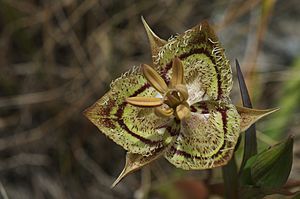Tiburon Mariposa lily facts for kids
Quick facts for kids Tiburon Mariposa lily |
|
|---|---|
 |
|
| Conservation status | |
| Scientific classification | |
| Genus: |
Calochortus
|
| Species: |
tiburonensis
|
The Tiburon Mariposa lily (scientific name: Calochortus tiburonensis) is a very rare and special flower. It belongs to the Calochortus group in the Liliaceae family, which includes lilies. This unique plant grows only in one small area in Marin County, California. You can find it on Ring Mountain, near Mill Valley. It likes to grow on a specific type of rock called serpentine in grassy areas, usually between 50 and 150 meters (about 164 to 492 feet) above sea level.
What Does It Look Like?
The Tiburon Mariposa lily is a perennial plant, meaning it lives for more than two years. It grows from a bulb, much like a tulip or onion. The plant can reach a height of 10 to 60 centimeters (about 4 to 24 inches). Each plant has a single leaf.
Every year, it produces between 2 and 7 upright flowers on a branching stem. The petals are a pretty light yellow-green color. They have tiny hairs along their edges and are streaked with purplish-brown lines. After the flowers bloom, their ovaries turn into capsules. These capsules are full of small, dark brown seeds.
Why Is It Special and Protected?
This lily is considered a threatened species by the United States government since 1995. This means it needs special protection to survive. There are a few reasons why it's in danger:
- Its home is shrinking because of human activities like building and recreation.
- Other plants, called invasive species, are moving into its area. These plants can take over and outcompete the lily for space and resources.
- It lives very close to a busy town, which increases the chances of its habitat being disturbed.
- The biggest problem is that all known Tiburon Mariposa lilies grow in just one single spot. If something bad happens there, the entire population could be wiped out.
The good news is that the land where the lily grows is protected. It's owned by the Marin County Open Space District. This area was once preserved by The Nature Conservancy, a group that works to protect nature. Scientists first learned about this plant in 1971, and it was officially described in 1973. It's protected along with other rare plants that also love the special serpentine soil found on Ring Mountain.
Even though the land is protected, the plants still face challenges. In 1991, experts estimated there were about 40,000 individual lilies. However, natural events like wildfires or droughts can harm them. People can also accidentally damage the plants. This can happen from off-leash dogs, hikers stepping off trails, cyclists, and even people who might try to collect the rare wildflowers. It's important for everyone to stay on marked paths and respect the plants to help keep them safe.


